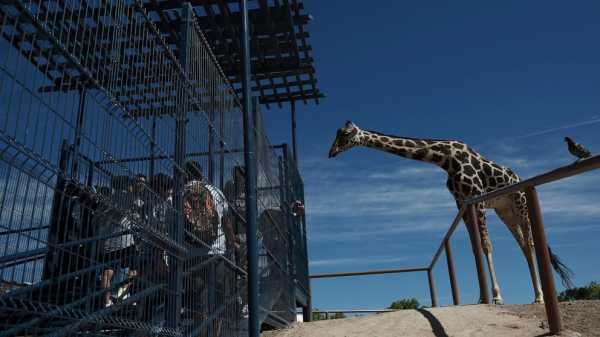
MEXICO CITY — Benito the giraffe arrived in Mexico’s arid northern border city of Ciudad Juarez just last month, and already the climate appears to be a problem — and he's only had to deal with the scorching heat of summer.
The snow and freezing temperatures of winter are still to come, and animal activists are up in arms and pushing a campaign under the hashtag “Save Benito” seeking to have the animal moved somewhere more hospitable.
On a recent day, the 3-year-old male giraffe could be seen crouching with only its head under a small, circular canopy for shade. The structure did little to protect him from a pelting rain and a hail storm later.
There is also a small shed for winter, but activists say it is cruel for the city-run Central Park to keep the giraffe in a small fenced enclosure, by himself, with only about a half acre to wander and few trees to nibble, in a climate he’s not used to.
“We have been fighting for a month, a group of animal activists, to demand that he be taken to an animal sanctuary, a zoo, somewhere where there are appropriate facilities and qualified personnel to care for this type of animal,” said Ana Félix, a Ciudad Juarez animal rights activist. “We are in the desert here and the climate here is extreme in winter and in summer.”
Blue Hills, a sanctuary ranch in Texas that rescues animals and books private tours to help offset the cost, has offered to buy or adopt Benito.
“We can offer him a brand new heated barn, so in the winter he doesn’t stand in the snow and freeze,” ranch operator Matt Lieberman wrote in response to The Associated Press. “We have an on-staff vet that cares for our animals and we have 24-hour staff for him."
He added that the giraffe would have 320 acres (130 hectares) to roam in. “He doesn’t have any trees to browse from” at the park in Mexico, Lieberman said. “He needs trees to eat from and keep stimulated.”
Benito appears to have just about finished off the only small trees within his reach at Central Park and can do little more than walk in circles.
Officials at the park reject the criticism, though they acknowledge they can't provide more trees. They say they are working to improve Benito's compound, saying his presence has been important in boosting the park's popularity among visitors, largely children. Monthly visits rose from about 140,000 before Benito arrived to 200,000.
Park visitor Derek Reyes, 11, had mixed feelings about Benito.
“He could be fine here,” Reyes said, "but it would also be good if they could take him to a place where they belong, with a herd.”
Park director Rogelio Muñoz said authorities are planning to build Benito a new, heated winter house by September.
The park is also building a larger sun canopy for the giraffe and dredging out garbage and fetid water from a pool that takes up much of the enclosure. Benito will have fresh water in a trough.
“The conditions, attention and care in the habitat of the park’s new resident are optimal for his stay,” the park wrote in a social media message.
Benito was donated by a zoo in the much more temperate climate of Sinaloa, a state on Mexico’s northern Pacific coast. Benito couldn't stay with two other giraffes at the Sinaloa zoo because they were a couple, and the male could become territorial and attack the younger Benito.
The giraffe's arrival was a point of pride for Ciudad Juarez, a tough, dusty city across from El Paso, Texas, that is best known for its hundreds of maquiladora assembly factories and its endemic gang violence. El Paso has giraffes at its zoo, the thinking goes, so why can't Ciudad Juarez?
“We want to be like El Paso,” Muñoz said.
Central Park, which also holds a few other animal species like ducks and donkeys, invited kids from across the city to come visit the new giraffe; the government of the border state of Chihuahua sponsored a contest among grade schoolers to name him.
The first prize — about $500 — went to a little girl who proposed the name “Benito.” One critic, Alfredo Casas, commented on Facebook, “They would have done better spending that money on better shade for the giraffe.”
The park had a giraffe for 21 years named Modesto. He died last year, and activists say they don’t want his experience — being alone and sometimes caught in the snow and frost — to be repeated for Benito.
“When Modesto died, we thought that was the end of it,” said Félix. “But then they bring us a new animal, and that really isn’t fair. It isn’t fair to repeat the story of Modesto.”
Muñoz acknowledged that Modesto's life was far from the best — children who used to visit the giraffe would feed him potato chips and snack foods. But park officials have launched a campaign to teach kids to bring Benito only lettuce and carrots.
Muñoz said he also doesn't want Benito to live out his life alone.
“When his quarters are fixed up, his house, with heating … then we want to bring in a female, because he cannot be alone,” Muñoz said.
Sourse: abcnews.go.com






